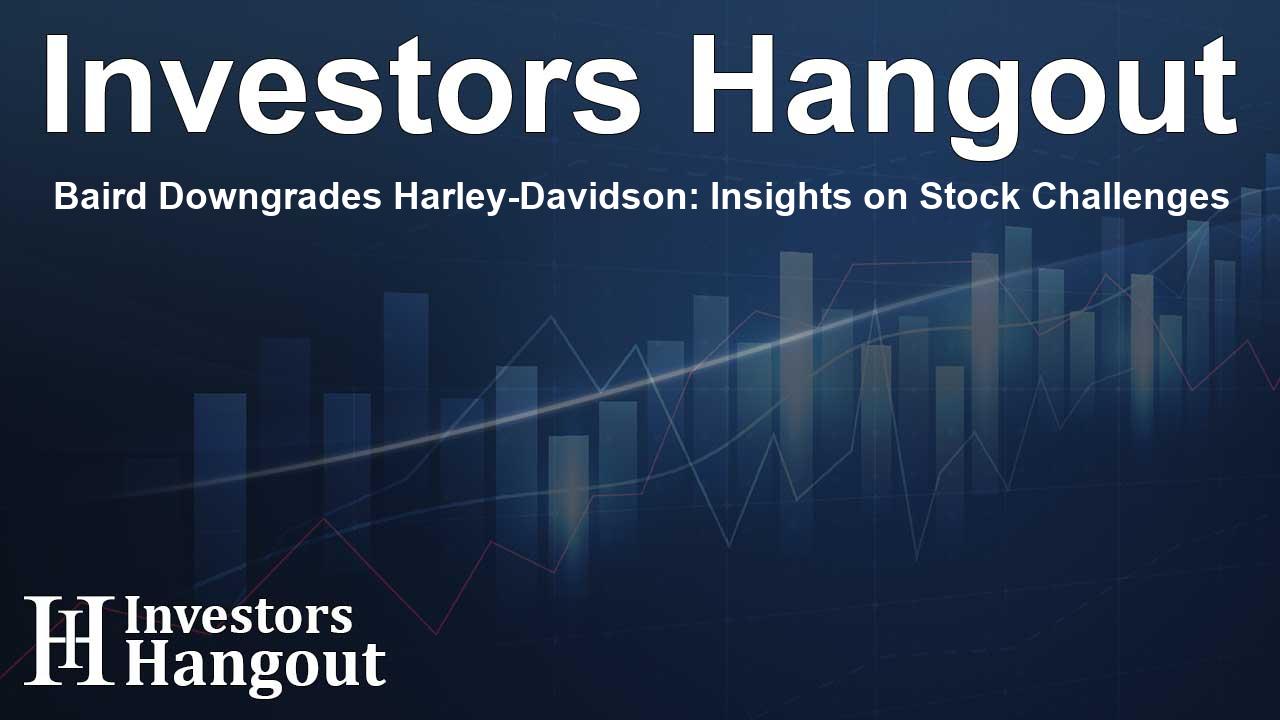Baird Downgrades Harley-Davidson: Insights on Stock Challenges

Baird Downgrades Harley-Davidson Stock Amid Concerns
Baird recently made headlines by downgrading Harley-Davidson (NYSE: HOG) from an Outperform rating to Neutral. This significant change was primarily driven by the feedback gathered from Harley-Davidson dealers, revealing worrying trends in retail performance, excess inventory levels, and a growing wave of negative sentiment surrounding the brand. Such insights may jeopardize the company's guidance moving forward.
Conversations with dealers highlighted numerous issues, including sluggish retail sales and an alarming surplus of inventory, compounded by a prevailing sense of dissatisfaction. These factors present potential challenges for the company’s financial outlook. The combination of sluggish sales and an oversupply of motorcycles has led to a cautious atmosphere among Harley-Davidson stakeholders.
This year has proven particularly challenging for Harley-Davidson, drawing attention in media circles for several factors contributing to the rising frustration among riders, dealers, and shareholders. This combination creates an environment that is less than favorable for a brand with such a storied legacy in the motorcycle industry.
Baird's analyst acknowledged the inherent value of the Harley-Davidson brand but urged caution regarding the immediate prospects of the company following the dealers' feedback. The notes from dealers emphasized a less optimistic view of short-term performance, prompting a more reserved approach toward the stock at this juncture.
With the revised price target set at $40, it reflects the concerns dealers have raised and the possible impacts on upcoming financial reports for Harley-Davidson. Investors are keenly awaiting the company's responses to the pronounced retail and inventory challenges, which will likely significantly affect stock performance and overall investor sentiment.
Recent Financial Insights
Insights from recent analyses provide further context to the Baird downgrade of Harley-Davidson. Despite the dealer feedback indicating significant challenges, the financials of HOG reveal a more nuanced picture. With a price-to-earnings (P/E) ratio of 7.74, Harley-Davidson appears to be trading at a relatively lower earnings multiple compared to industry standards, which could attract value investors looking for opportunities.
Moreover, Harley-Davidson has successfully maintained dividend payments for 32 consecutive years, showcasing a commitment to shareholder returns amidst adversity. This dedication to dividends may provide investors with reassurance and stability as the company navigates its current retail hurdles. Additionally, robust cash flows allow the company to comfortably manage interest payments, mitigating concerns surrounding inventory pressures.
Remarkably, HOG has demonstrated notable resilience in the past three months, recording a total price return of 19.47%. This performance starkly contrasts the feedback from dealers and suggests that prior to the downgrade, the market was factoring in stronger expectations for the motorcycle brand.
Key Considerations Moving Forward
While Baird’s downgrade sheds light on present challenges, it is essential for potential investors to consider the broader implications of Harley-Davidson's strategies and responses to the existing hurdles. Analyzing the effectiveness of the company's supply chain management and retail strategies will be crucial in determining how it tackles inventory issues moving forward.
Investors should remain vigilant, weighing the potential risks against the long-term growth prospects that Harley-Davidson could present. The global motorcycle market is evolving, and how Harley-Davidson adapts to emerging trends could play a critical role in shaping its future trajectory.
In conclusion, while the downgrade by Baird raises essential questions on Harley-Davidson’s immediate outlook, the company’s historical commitment to customers and shareholders might provide grounds for cautious optimism amid these challenges.
Frequently Asked Questions
What prompted Baird to downgrade Harley-Davidson's stock?
Baird downgraded Harley-Davidson due to feedback from dealers indicating weaker retail performance, excess inventory, and negative sentiment surrounding the brand.
What is the new price target for Harley-Davidson stock?
The revised price target for Harley-Davidson stock is set at $40, down from $44.
How has Harley-Davidson's stock performed recently?
Harley-Davidson experienced a total price return of 19.47% over the last three months, despite current dealer feedback suggesting challenges.
What has been Harley-Davidson's dividend history?
Harley-Davidson has maintained dividend payments for 32 consecutive years, indicating strong commitment to its shareholders.
What are the long-term prospects for Harley-Davidson?
While challenges exist, Harley-Davidson's historical commitment and potential strategies to adapt to market changes may offer grounds for cautious optimism.
About Investors Hangout
Investors Hangout is a leading online stock forum for financial discussion and learning, offering a wide range of free tools and resources. It draws in traders of all levels, who exchange market knowledge, investigate trading tactics, and keep an eye on industry developments in real time. Featuring financial articles, stock message boards, quotes, charts, company profiles, and live news updates. Through cooperative learning and a wealth of informational resources, it helps users from novices creating their first portfolios to experts honing their techniques. Join Investors Hangout today: https://investorshangout.com/
Disclaimer: The content of this article is solely for general informational purposes only; it does not represent legal, financial, or investment advice. Investors Hangout does not offer financial advice; the author is not a licensed financial advisor. Consult a qualified advisor before making any financial or investment decisions based on this article. The author's interpretation of publicly available data shapes the opinions presented here; as a result, they should not be taken as advice to purchase, sell, or hold any securities mentioned or any other investments. The author does not guarantee the accuracy, completeness, or timeliness of any material, providing it "as is." Information and market conditions may change; past performance is not indicative of future outcomes. If any of the material offered here is inaccurate, please contact us for corrections.